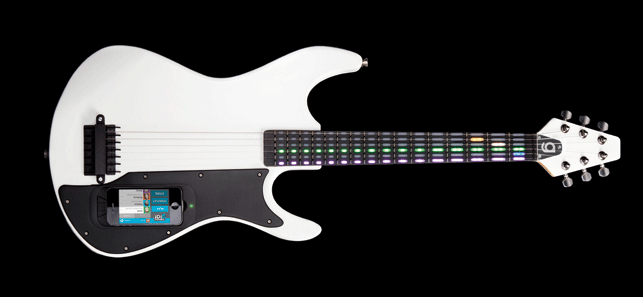Fret no more
Many of us reach adulthood having wished we’d learnt to play the guitar when we were younger. Well, you are never too old and the gTar makes it easier than ever.

The gTar has a multi-touch LED fretboard that can show you what to play and track whether you’re doing it correctly
Developed by Incident in San Francisco, the gTar is a digital guitar that enables anyone, however inexperienced, to learn how to play before progressing onto a traditional guitar.
Essentially, you dock your iPhone into the body, start up the gTar app and select a song to play along with. Then an array of interactive LEDs along the fretboard will light up showing you exactly what to play. Sensors will then relay what you’re playing back to the iPhone, which then generates the sound.
“Everybody looks at this and says ‘Oh, it’s like Guitar Hero for real. Well, that is kind of what it is,” smiles Stefan Lindsay of gTar.
The gTar is the brainchild of Idan Beck who founded Incident out of his parent’s Silicon Valley garage in 2009. With a degree in electrical computer engineering and having given up his job at Microsoft, he was on a mission to bring his idea for a guitar, which acts as a computer and that apps could be built for, to market.
At this stage the Incident team was up to five and although they had some investors onboard, including the creator of Guitar Hero, RedOctane, in order to bring it to market they needed more funding and so launched a Kickstarter campaign in mid-2012.
They’d hoped for $100,000 to help complete manufacture, assembly and testing, but ended up with $353,392. A huge amount but it was needed. “We were moving a product that’s extremely technologically sophisticated, physically heavy and very complex to build. It took us some time to complete shipping.
Now we have figured it out, and it’s been an interesting process,” admits Beck.
The guitars are made in China and shipped world wide. But it’s not just the development of the hardware, but the software too. gTar now has more than 150 compatible apps meaning it can be a drum machine or a synthesiser.
“We have an open platform for developers so they can do what they want to with it – whether it’s learning software, video games or apps,” says Lindsay.
The gTar launched in the UK at this year’s Gadget Show Life for £349.
incidentgtar.com
Keys to success
The C.24 may look like an ordinary protective cover for an iPad but at the touch of a spring-loaded latch it transforms into a piano-style keyboard.

The Miselu C.24
Developed by San Francisco start-up Miselu, the C.24 is a two octave (24-key) wireless music keyboard designed specifically for an iPad 2, 3 or 4.
“Apple has done an excellent job of creating an eco-system of software apps for music. The only component that was left was to do the hardware part.
“So, our product, which is going into production right now, is a physical keyboard for any music app and uses Core MIDI over Bluetooth,” explains Lee Foster Powers, Miselu’s senior mechanical engineer.
The Miselu team have designed a clever collapsible design that when opened, the C.24’s white and black keys spring up and out. The iPad is then placed into a slot on top, almost like reading music off a stand, the app is selected and playing can begin, wherever you may be.
Powers explains that the hardware was designed in Solid Edge and GrabCAD were used extensively amongst the team and their suppliers to share and store CAD drawings.
“We’re looking forward to getting this product out there soon,” says Powers.
miselu.com
Hear, hear
Over in Denmark hearing aid manufacturer ReSound has been hard at work developing the first ‘Made for iPhone’ hearing aids.

The ReSound Linx in use outside
With the ReSound Linx, users can control their hearing aid and stream audio directly from an iPhone, iPad or iPod Touch.
Integrating Bluetooth smart technology and a 2.4 GHz wireless chip, wearers can adjust volume to suit the environment whether they are in a quiet restaurant or a noisy sports stadium.
The app’s geo-tagging feature will then remember this and make the adjustments automatically the next time they return to that location.
More like wireless stereo headphones than hearing aids, ReSound Linx can also stream audio directly from the user’s iPhone. Additionally, phone calls can be taken and turn-by-turn directions relayed.
The device itself is so small that it fits behind the user’s ear that it’s almost undetectable.
During the design process, ReSound designers used Creo for CAD modelling and Abaqus for Finite Element Analysis.
They also made use of 3D printing to make the numerous prototypes.
These well-designed hearing aids are now available to purchase in the UK.
resoundlinx.com

A look at three products designed to be connected to iOS devices
Default






